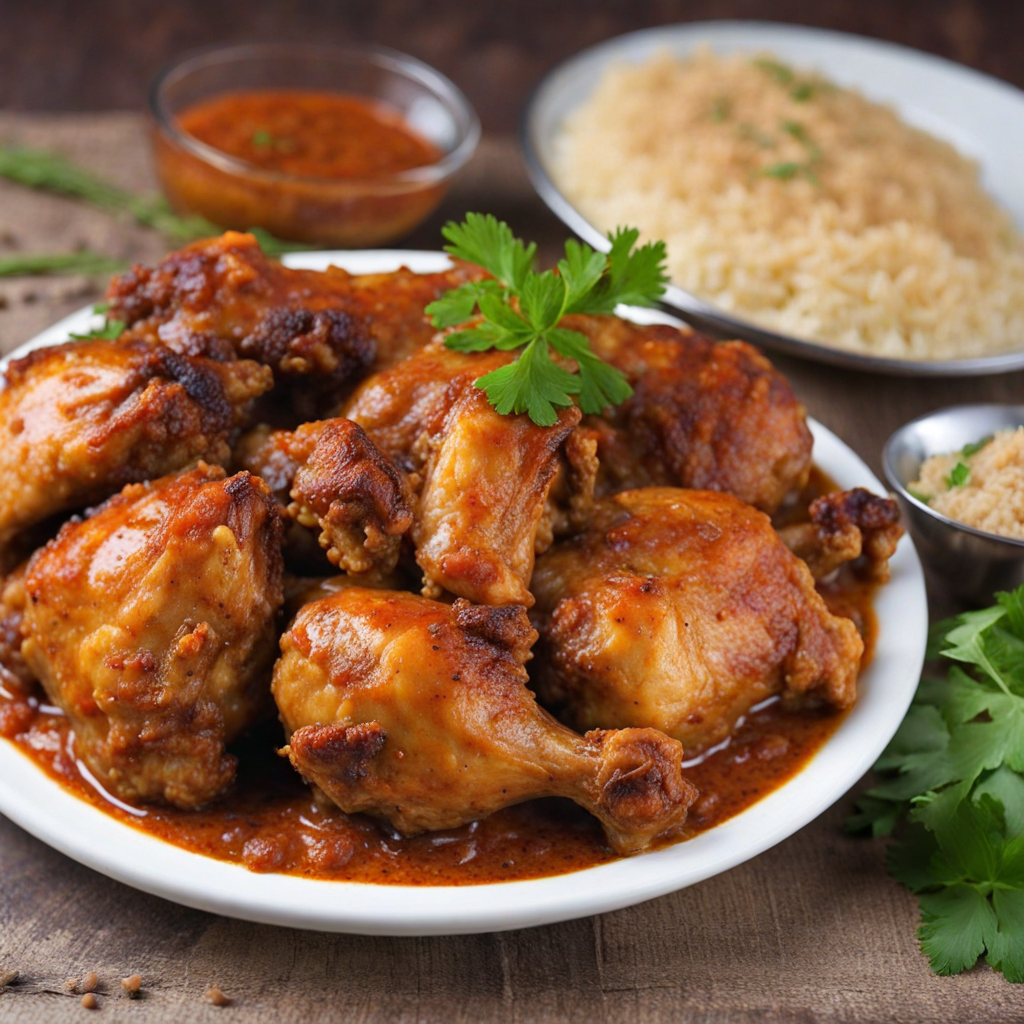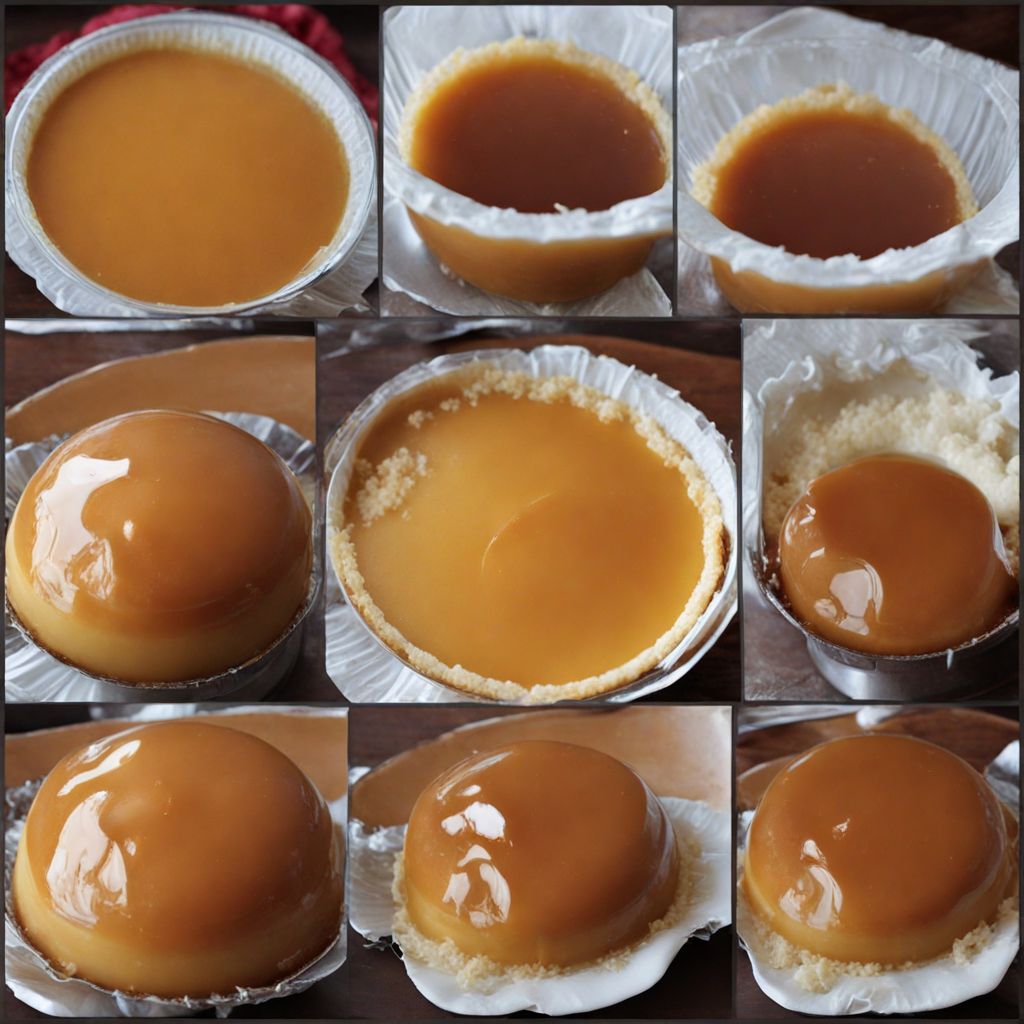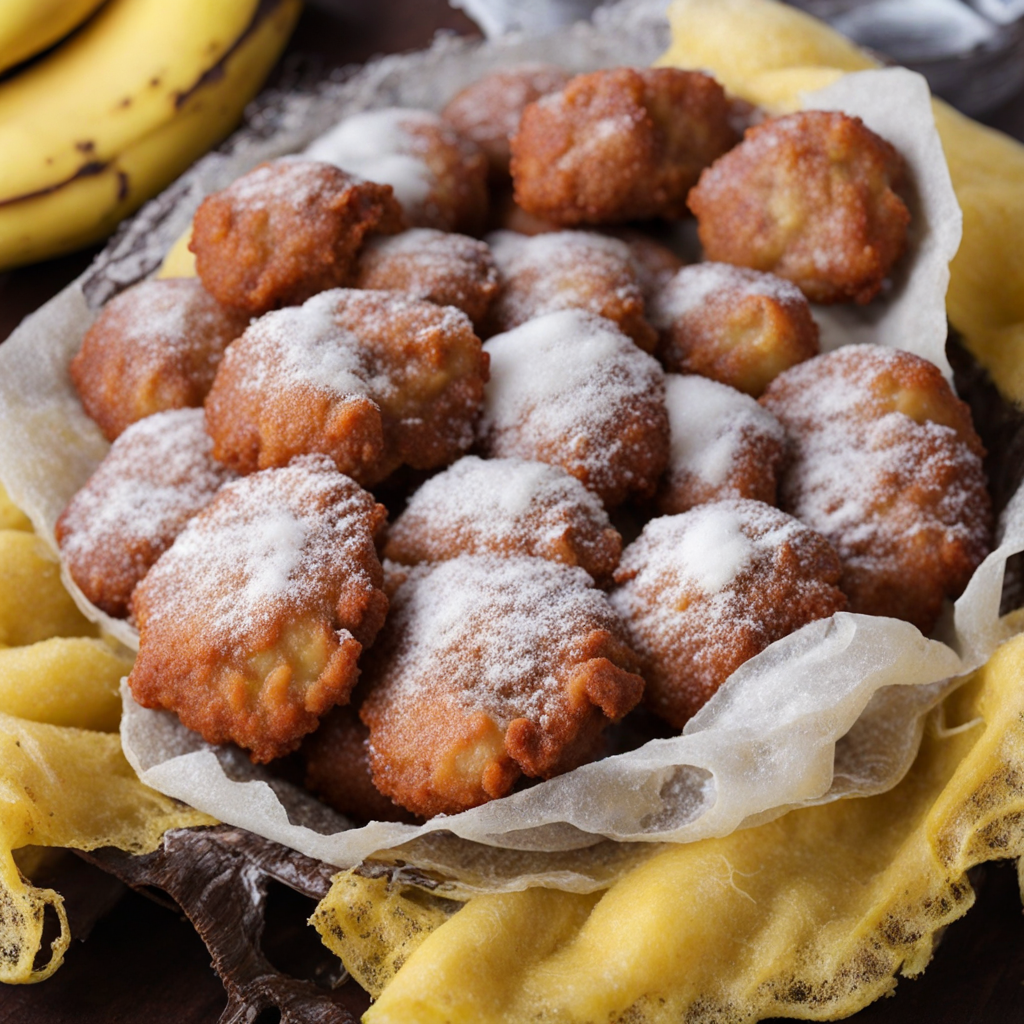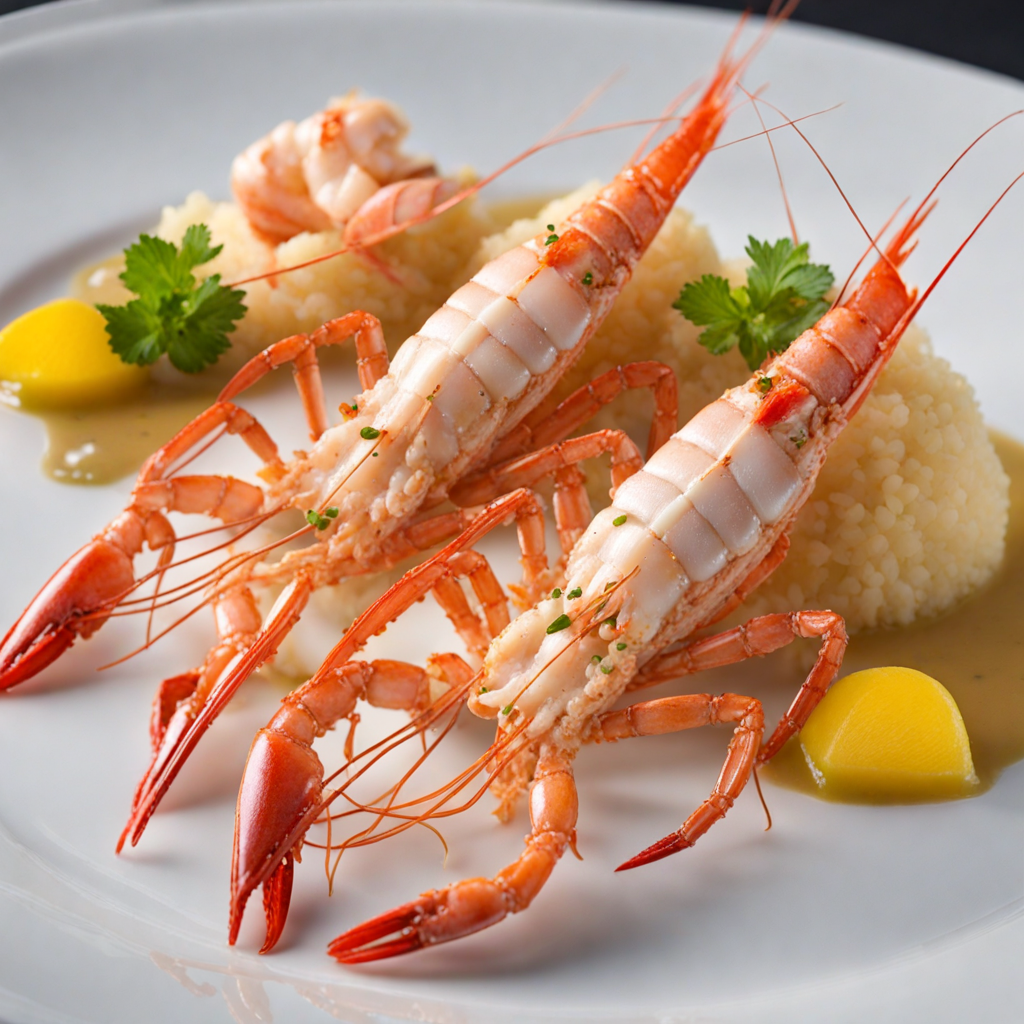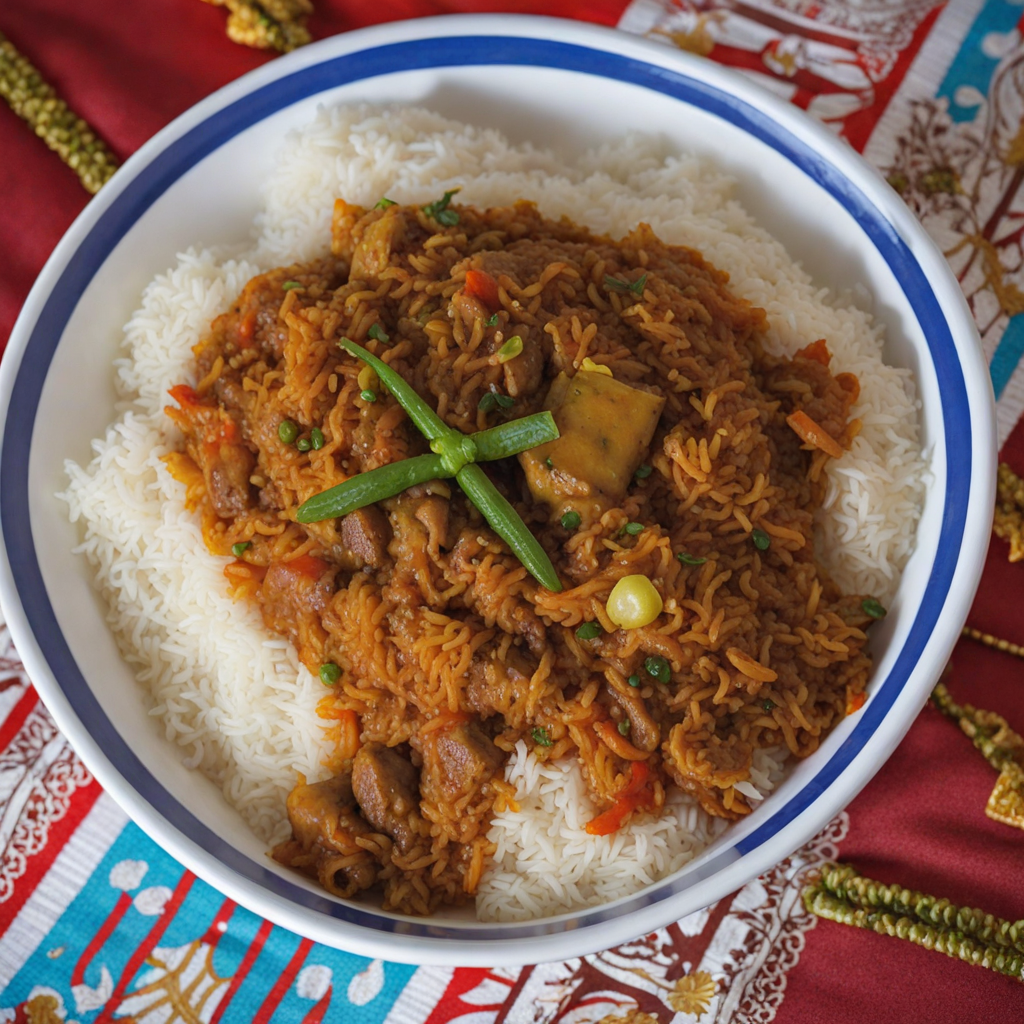Poulet à la Moambe
Poulet à la Moambe is a delightful dish that brings the flavors of the Comoros islands to your plate. At its core, this dish features tender chicken simmered in a rich, savory sauce made primarily from moambe, which is a palm nut paste. This unique ingredient contributes a deep, earthy flavor that envelops the chicken, infusing it with a luscious creaminess. The dish is often enhanced with a blend of spices such as garlic, ginger, and chili, which not only add depth but also a gentle kick that tantalizes the palate. The preparation of Poulet à la Moambe is as important as the ingredients themselves. The chicken is typically marinated to absorb the flavors, then slow-cooked to ensure it becomes melt-in-your-mouth tender. As it simmers, the moambe sauce thickens, creating a beautiful, glossy coating that beckons to be paired with traditional accompaniments. It is common to serve this dish alongside fluffy rice or starchy plantains, which help to soak up the delightful sauce and balance the rich flavors of the chicken. Each bite of Poulet à la Moambe is a celebration of the culinary heritage of the Comoros, showcasing both the simplicity and complexity of island cooking. The dish embodies a harmonious blend of local ingredients, with the tropical climate of the Comoros contributing to the freshness of the spices and herbs used. For those seeking to explore new tastes, Poulet à la Moambe offers an exciting journey through the vibrant flavors of this unique island nation, making it a must-try for any adventurous food lover.
How It Became This Dish
Poulet à la Moambe: The Culinary Jewel of the Comoros Origins and Historical Context Poulet à la Moambe, or chicken in a rich, peanut-based sauce, is a signature dish from the Comoros, an archipelago located off the southeastern coast of Africa in the Indian Ocean. The Comoros consists of three main islands—Grande Comore, Mohéli, and Anjouan—and several smaller islands, all known for their lush landscapes and vibrant cultures. The islands have been influenced by a variety of cultures over the centuries, including African, Arab, French, and Malagasy traditions, which contribute to the unique culinary landscape of the region. The origins of Poulet à la Moambe can be traced back to the arrival of the Bantu people, who brought with them agricultural practices and a variety of ingredients that would become staples in Comorian cuisine. The use of chickens in cooking is prevalent across many cultures, but the distinct preparation of Poulet à la Moambe highlights the unique ingredients native to the islands and the influence of trade routes that brought new flavors and techniques to the region. The name "moambe" itself has roots in Central African culinary traditions, particularly in the Republic of the Congo, where “moambe” refers to a sauce made with palm nuts. In the Comoros, however, the dish has evolved to incorporate local ingredients, notably the ground peanuts that are abundantly grown on the islands. The dish exemplifies the adaptability and creativity of Comorian chefs, who have transformed a simple recipe into a celebration of local flavors and cultural heritage. Cultural Significance In Comorian culture, food is more than sustenance; it is a central aspect of social life, community bonding, and cultural identity. Poulet à la Moambe is often served at significant gatherings, including weddings, religious celebrations, and communal feasts. The preparation and sharing of this dish symbolize hospitality and warmth, reflecting the Comorian ethos of community and connection. The dish is also a representation of the islands' agricultural bounty. Peanuts, which are a key ingredient, are not only a dietary staple but also a significant cash crop for local farmers. The cultivation of peanuts, along with other ingredients used in Poulet à la Moambe, such as onions, garlic, and spices, illustrates the interplay between agriculture and culinary practices in the Comoros. Ingredients and Preparation The traditional preparation of Poulet à la Moambe begins with marinating the chicken, typically cut into pieces, in a mixture of spices, garlic, and sometimes citrus juices. This step is crucial as it infuses the meat with rich flavors. The marinated chicken is then browned in a pot before being simmered with a sauce made from ground peanuts, tomatoes, and a blend of local spices, which can include chili peppers, ginger, and turmeric. The creamy, nutty sauce is the hallmark of the dish, and it is often served alongside accompaniments such as rice, cassava, or plantains. The combination of flavors—savory, nutty, and slightly spicy—creates a dish that is both comforting and deeply satisfying. Evolution Over Time As the Comoros has navigated its history of colonization and independence, the culinary practices have also evolved. French colonial influence during the 19th and early 20th centuries introduced new cooking techniques and ingredients, which were woven into the existing fabric of Comorian cuisine. Poulet à la Moambe, while retaining its traditional roots, has seen adaptations that reflect modern tastes and global culinary trends. In recent years, the rise of culinary tourism has brought international attention to Comorian dishes, including Poulet à la Moambe. Chefs and food enthusiasts from around the world have begun to explore the flavors of the Comoros, leading to a renaissance of traditional dishes. Contemporary chefs are experimenting with the classic recipe by incorporating additional elements like coconut milk for enhanced creaminess or using local herbs to elevate the flavor profile. Moreover, the dish has found its way into the diaspora. Comorians living abroad have brought their culinary traditions with them, sharing Poulet à la Moambe in their communities and adapting it to local ingredients. This cross-cultural exchange has allowed the dish to evolve while remaining a symbol of Comorian identity. Conclusion Poulet à la Moambe is more than just a delicious dish; it is a culinary artifact that tells the story of the Comoros—its history, culture, and the resilience of its people. As it continues to evolve in response to both local and global influences, the dish remains a cherished part of Comorian heritage. Through generations, the preparation and enjoyment of Poulet à la Moambe foster connections among families and communities, ensuring that this culinary treasure endures. In today’s world, where culinary boundaries are increasingly blurred, Poulet à la Moambe stands as a testament to the richness of the Comorian culinary tradition. It invites those who partake in it to experience the islands' flavors, history, and culture, serving as a reminder of the power of food to unite and celebrate a shared identity. Whether enjoyed at a family gathering or a fine dining restaurant, Poulet à la Moambe embodies the spirit of the Comoros and its people—a dish that is both rooted in tradition and open to the world.
You may like
Discover local flavors from Comoros


